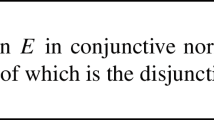Abstract
Let \(G=(V,E)\) be a simple graph without isolated vertices. A set \(S\) of vertices is a total dominating set of a graph \(G\) if every vertex of \(G\) is adjacent to some vertex in \(S\). A paired dominating set of \(G\) is a dominating set whose induced subgraph has a perfect matching. The minimum cardinality of a total dominating set (respectively, a paired dominating set) is the total domination number (respectively, the paired domination number). Hu and Xu (J Combin Optim 27(2):369–378, 2014) computed the exact values of total and paired domination numbers of Cartesian product \(C_n\square C_m\) for \(m=3,4\). Graph bundles generalize the notions of covering graphs and Cartesian products. In this paper, we generalize these results given in Hu and Xu (J Combin Optim 27(2):369–378, 2014) to graph bundle and compute the total domination number and the paired domination number of \(C_m\) bundles over a cycle \(C_n\) for \(m=3,4\). Moreover, we give the exact value for the total domination number of Cartesian product \(C_n\square C_5\) and some upper bounds of \(C_m\) bundles over a cycle \(C_n\) where \(m\ge 5\).





Similar content being viewed by others
References
Cockayne EJ, Dawes RM, Hedetniemi ST (1980) Total domination in graphs. Networks 10:211–219
Gavlas H, Schultz K (2002) Efficient open domination. Electron Notes Discrete Math 11:681–691
Gonçalves D, Pinlou A, Rao M, Thomassé S (2011) The domination number of grid graphs. SIAM J Discrete Math 25(3):1443–1453
Gravier S (2002) Total domination number of grid graphs. Discrete Appl Math 121:119–128
Haynes TW, Slater PJ (1995) Paired-domination and the paired-domatic number. Congresses Numerantium 109:65–72
Haynes TW, Slater PJ (1998) Paired-domination in graphs. Networks 32:199–206
Haynes TW, Hedetniemi ST, Slater PJ (1998a) Fundamentals of domination in graphs. Marcel Dekker, New York
Haynes TW, Hedetniemi ST, Slater PJ (eds) (1998b) Domination in graphs: advanced topics. Marcel Dekker, New York
Henning MA (2009) A survey of selected recent results on total domination in graphs. Discrete Math 309(1):32–63
Hu F-T, Xu J-M (2014) Total and paired domination numbers of toroidal meshes. J Combin Optim 27(2):369–378
Klavžar S, Seifter N (1995) Dominating Cartesian products of cycles. Discrete Appl Math 59:129–136
Kwak JH, Lee J (1990) Isomorphism classes of graph bundles. Can J Math XLII:747–761
Liu J, Zhang X, Chen X, Meng J (2010) On domination number of Cartesian products of directed cycles. Inform Process Lett 110(5):171–173
Liu J, Zhang X, Chen X, Meng J (2011) On domination number of Cartesian product of directed paths. J Combin Optim 22(4):651–662
Mollard M (2013) On the domination of Cartesian product of directed cycles: results for certain equivalence classes of lengths. Discuss Math Graph Theory 33:387–394
Mollard M (2014) The domination number of Cartesian product of two directed paths. J Combin Optim 27:144–151
Pfaff J, Laskar RC, Hedetniemi ST (1983) NP-completeness of total and connected domination and irredundance for bipartite graphs. Technical report 428. Department of Mathematical Sciences, Clemson University, Clemson
Pisanski T, Vrabec J (1982) Graph bundles (unpublished manuscript)
Proffitt KE, Haynes TW, Slater PJ (2001) Paired-domination in grid graphs. Congresses Numerantium 150:161–172
Shaheen R (2009) Domination number of toroidal grid digraphs. Util Math 78:175–184
Xu J-M (2003) Theory and application of graphs. Kluwer, Dordrecht
Zhang X, Liu J, Chen X, Meng J (2010) On domination number of Cartesian products of directed cycles. Inform Process Lett 111:36–39
Acknowledgments
The authors would like to express their gratitude to the anonymous referees for their critical commons and helpful suggestions on the original manuscript, which resulted in this version. This research was supported by Basic Science Research Program through the National Research Foundation of Korea (NRF) funded by the Ministry of Education, Science and Technology (2012R1A1A2005115). The first author was supported by NNSF of China (No. 11401004), Anhui Provincial Natural Science Foundation (No. 1408085QA03), and the doctoral scientific research startup fund of Anhui University.
Author information
Authors and Affiliations
Corresponding author
Rights and permissions
About this article
Cite this article
Hu, FT., Sohn, M.Y. & Chen, Xg. Total and paired domination numbers of \(C_m\) bundles over a cycle \(C_n\) . J Comb Optim 32, 608–625 (2016). https://doi.org/10.1007/s10878-015-9885-7
Published:
Issue Date:
DOI: https://doi.org/10.1007/s10878-015-9885-7




